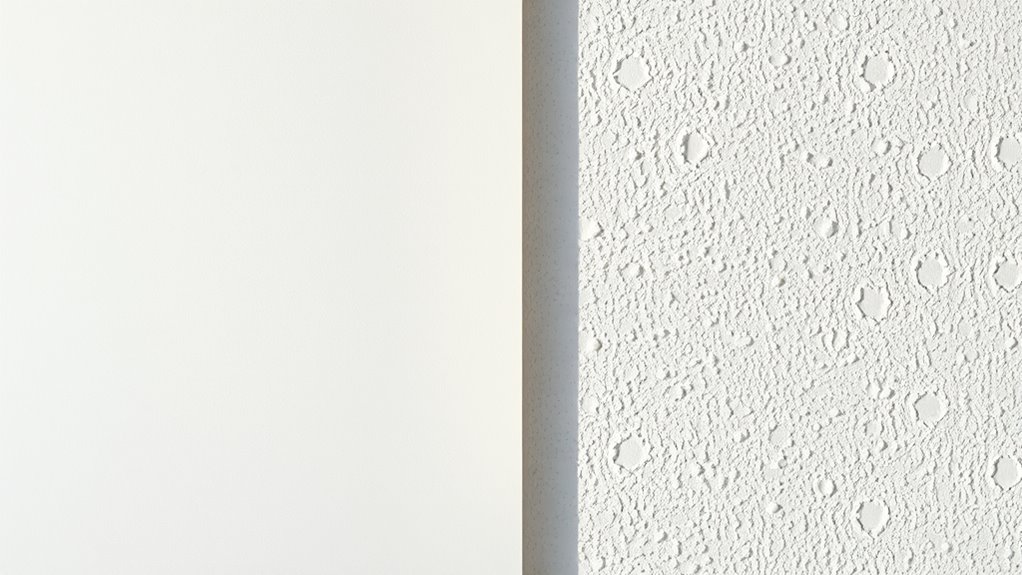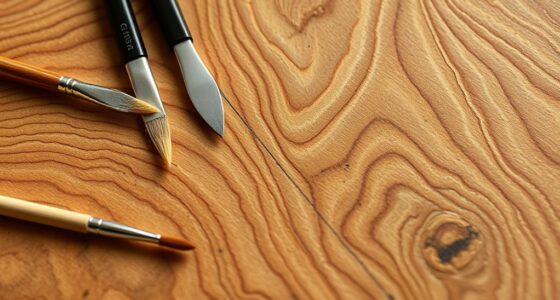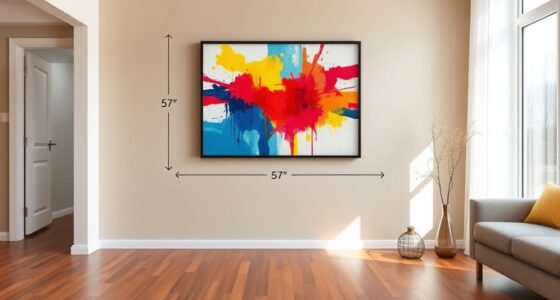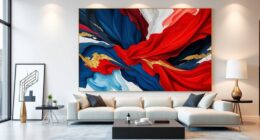When choosing a roller nap for smooth versus textured walls, consider shorter naps of 1/4 to 3/8 inch for sleek surfaces, as they help you attain a smooth, even finish with better control. For rough or textured walls, opt for longer naps of 1/2 inch or more to reach into crevices and guarantee complete coverage. The right nap makes your job easier and results cleaner. Keep going to discover how to select the perfect cover for any wall surface.
Key Takeaways
- Use a 1/4 to 3/8 inch nap roller for smooth walls to achieve even, fine finishes.
- Choose a 1/2 inch or longer nap for textured or rough surfaces to reach into crevices.
- Longer naps hold more paint, ensuring better coverage on uneven textures.
- Shorter naps provide better control and cleaner results on smooth, sleek walls.
- Select ergonomic handles for both smooth and textured surfaces to reduce fatigue during application.
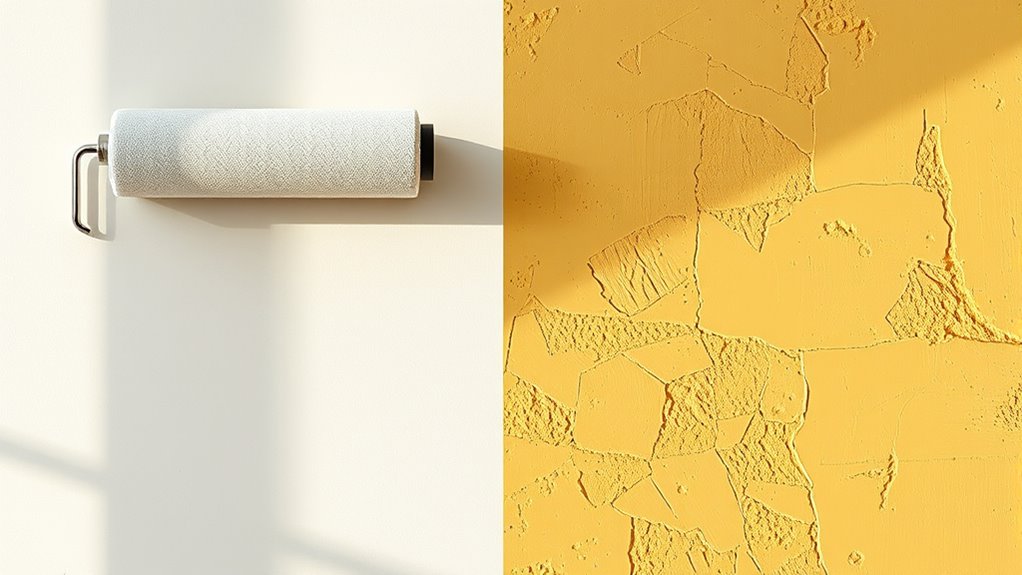
Choosing the right roller nap is essential for achieving the desired finish on your project, whether you’re painting walls, furniture, or other surfaces. Your choice directly impacts the paint consistency you can achieve and the ease of use, especially when considering roller handle ergonomics. A well-suited nap helps you apply paint evenly, reducing drips and brush marks, and ensures a professional-looking result.
Choosing the right roller nap ensures smooth, even finishes with less effort and better control.
When working on smooth walls, a shorter nap—usually around 1/4 to 3/8 inch—is your best bet. These shorter rollers are designed to hold less paint, which is perfect for creating a fine, smooth finish. They allow for better control and precision, giving you a sleek look without texture. You’ll find that the paint consistency with these rollers is more uniform because they don’t hold excess paint, making application cleaner and more controlled. Plus, with a shorter nap, your roller handle ergonomics become even more critical. A comfortable, well-designed handle reduces fatigue during extended painting sessions, allowing you to maintain steady pressure and avoid uneven coverage.
Conversely, textured walls or surfaces with rough or uneven finishes call for a longer nap, typically 1/2 inch or more. These rollers are engineered to reach into crevices and uneven surfaces, ensuring the paint covers all areas thoroughly. The increased nap thickness holds more paint, which is beneficial for textured surfaces because it fills in rough patches and provides a consistent coat. However, because these rollers carry more paint, you need to be mindful of paint consistency—too much paint can lead to drips and uneven texture. Here, selecting a roller with an ergonomic handle becomes even more important, as the heavier load can cause hand fatigue. A handle that fits comfortably in your hand and offers good grip helps you maintain control, especially when covering large or rough surfaces.
Ultimately, your choice of roller nap should align with your surface type and desired finish. Smooth surfaces demand shorter naps for a sleek appearance, while textured surfaces require longer naps to ensure full coverage. Incorporate a roller with good handle ergonomics to make your work easier and more comfortable, especially during long sessions. Consider how the paint will flow and stick—too thick, and you’ll struggle with drips; too thin, and the finish might look uneven. Finding the right combination of nap length, paint consistency, and ergonomic handle design ensures you get the best possible results with less effort. Additionally, understanding offensive security techniques can help you better evaluate vulnerabilities in your projects, similar to how selecting the proper roller enhances your finish.
Frequently Asked Questions
How Does Wall Texture Affect Paint Coverage?
Wall texture greatly impacts paint coverage by affecting wall preparation and paint adhesion. A textured surface requires a thicker or more specialized roller nap to ensure even coverage, while smooth walls need less. If you use the wrong nap, paint may not adhere well or cover unevenly, leading to more coats. Choosing the right roller nap helps you achieve better coverage and a professional finish, especially on textured walls.
Can Different Nap Types Be Mixed in One Project?
You can mix different nap types during a project, but it’s best to plan carefully. Proper wall prep guarantees each section gets ideal coverage, while consistent roller storage preserves nap effectiveness. Use a smooth nap for ceilings and flat walls, and textured nap for rough surfaces. By switching naps thoughtfully, you maintain uniform color and texture, avoiding uneven finishes. Just remember to clean rollers thoroughly and store them properly between uses.
How Do I Clean a Textured Wall Roller?
To clean a textured wall roller, first rinse it with warm water to remove excess paint. Use a mild soap if needed, gently scrubbing the roller to maintain wall texture maintenance. Check the roller nap compatibility—textured rollers often require softer or more durable naps. Rinse thoroughly and let it air dry to keep it in good condition for your next project. Proper cleaning guarantees your roller lasts longer and performs well on textured surfaces.
Are There Eco-Friendly Roller Nap Options?
Did you know eco-friendly coatings now come with biodegradable rollers? You can choose these eco-friendly options to reduce environmental impact while painting. Biodegradable rollers are made from sustainable materials that break down naturally, making your project greener. These rollers work well with eco-friendly paints and coatings, ensuring you get a smooth finish without harming the planet. Switching to biodegradable rollers is a simple step toward more sustainable painting practices.
What Is the Best Roller Nap for High-Gloss Paints?
For high-gloss paints, you should use a short nap roller, typically ⅛ to ¼ inch. This provides a smooth finish, minimizing texture. Before you start, apply a paint primer for better adhesion. Use a roller extension to reach high areas comfortably, ensuring even coverage. This combination helps achieve a sleek, professional look with high-gloss paints, reducing spray and drips for a flawless finish.
Conclusion
Think of choosing your roller nap like picking the right brush for a masterpiece. A smooth wall is your canvas, demanding a gentle touch with a soft nap to create a flawless finish. Textured walls are like rugged terrain—requiring a thicker nap to navigate every nook and cranny. By selecting the right roller nap, you’re not just painting walls—you’re crafting a work of art. So, pick wisely, and let your brush tell your story.
